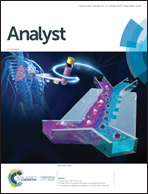Nitro-functionalized metal–organic frameworks with catalase mimic properties for glutathione detection†
Abstract
In the present study, four copper-based metal–organic frameworks were facilely prepared to study the effects of the substituent groups of the ligand on the enzyme-like properties of these frameworks. It was found that all of them were capable of catalyzing the reaction between 3,3′,5,5′-tetramethylbenzidine (TMB) and H2O2; this demonstrated their enzyme-like properties. Moreover, the enzyme-like catalytic properties of all the Cu-MOFs obtained herein were studied in detail. Interestingly, the results indicate that the four Cu-MOFs should be addressed as different enzyme mimics although the chemical structures of their ligands are quite similar. Among these four MOFs, the Cu-MOF with the –NO2 group (Cu-MOF (ii)) exhibits highest catalytic activity at neutral pH, which would be beneficial for its application in real biological samples. Moreover, its catalytic activity should be ascribed to the generation of oxygen induced by Cu-MOF (ii)-catalyzed H2O2 decomposition; this accordingly indicates that this MOF should be called a catalase mimic. Under optimized conditions, the Cu-MOF (ii) was applied to develop a (GSH) colorimetric assay for glutathione (GSH). In addition, GSH detection in serum was performed, and satisfactory results were obtained. Therefore, a simple, sensitive and selective colorimetric assay based on the MOF catalase mimic for the detection of GSH was developed.



 Please wait while we load your content...
Please wait while we load your content...